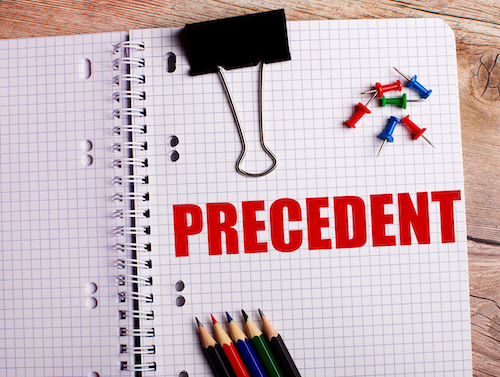“Whereas ADASA’s brief in opposition argued that the only issue is the Federal Circuit’s expanded use of Section 101 to invalidate patent claims, Avery Dennison contends that a decision seen to be lowering the patent eligibility bar ‘will be overread and misused by one side of the raging debate.’”
 On May 8, digital ID solutions company Avery Dennison filed a reply brief with the U.S. Supreme Court in support of its petition for writ of certiorari to appeal the U.S. Court of Appeals for the Federal Circuit’s decision last December affirming the validity of patent claims owned by ADASA. Of the cert petitions currently before the Supreme Court involving issues of patent subject matter eligibility under 35 U.S.C. § 101, Avery Dennison contends that its appeal provides the most useful vehicle for clarifying Section 101 invalidity in information management and technology, a field where the Federal Circuit’s division on patent eligibility “is especially stark and recurrent.”
On May 8, digital ID solutions company Avery Dennison filed a reply brief with the U.S. Supreme Court in support of its petition for writ of certiorari to appeal the U.S. Court of Appeals for the Federal Circuit’s decision last December affirming the validity of patent claims owned by ADASA. Of the cert petitions currently before the Supreme Court involving issues of patent subject matter eligibility under 35 U.S.C. § 101, Avery Dennison contends that its appeal provides the most useful vehicle for clarifying Section 101 invalidity in information management and technology, a field where the Federal Circuit’s division on patent eligibility “is especially stark and recurrent.”
ADASA’s RFID Invention ‘No More Patentable’ Than Sequencing Phone Numbers
Avery Dennison first filed its petition for cert in late February of this year, about two months after the Federal Circuit upheld the validity of claim 1 of ADASA’s U.S. Patent No. 9789967, Systems, Methods, and Devices for Commissioning Wireless Sensors. The ‘967 patent claims a radio-frequency identification (RFID) transponder incorporating a system for generating unique serial numbers useful for on-demand and point-of-use commissioning of RFID transponders without requiring the use of a centralized label printing facility or bulky label printing equipment used on-site.
Avery Dennison’s petition argued that ADASA’s asserted patent claim did nothing more than claim the abstract idea of separating one serial number into two shorter components, with certain “most significant” digits corresponding to an allocated block, while utilizing conventional RFID hardware components. In a brief in opposition filed by ADASA on May 2, the patent owner argued that the patent’s claims to “an RFID transponder” directed the claimed invention to a technological structure and not a mathematical formula or abstract idea.
The recent reply brief filed by Avery Dennison doubles down on the petitioner’s abstract idea contentions, arguing that ADASA’s claimed invention “is no more patentable than directing that all telephone numbers be subdivided into two shorter components, and that all numbers allocated to the District of Columbia begin with 202, with the area code dubbed ‘most significant.’” The Federal Circuit’s ruling that the claimed hardware-based data structure conferred Section 101 eligibility on the patent claim flies in the face of Supreme Court precedent from Alice Corp. v. CLS Bank International (2014) foreclosing patent eligibility for abstract ideas applied through conventional hardware components, Avery Dennison asserted.
CAFC Decision ‘Will Be Overread and Misused’ by Section 101 Detractors
While ADASA’s brief in opposition contended that fact-bound claim construction issues would complicate the Supreme Court’s review of the legal questions presented by Avery Dennison, the petitioner’s reply noted that the district court repeatedly affirmed the Section 101 eligibility of ADASA’s patent claims, including on summary judgment. Further, the petitioner pushed back on ADASA’s views that upcoming district court proceedings on novelty and obviousness could moot Avery Denison’s appeal, as Section 101 is a threshold issue on patent eligibility. The Federal Circuit’s failure to consider patent eligibility at both steps of the Alice/Mayo Section 101 framework also didn’t foreclose Avery Dennison’s appeal, the petitioner argued, as ADASA’s arguments on the inventive concept covered by its patent claims could be assessed by the Supreme Court.
Judges who have rendered decisions on either side of Section 101 have “clamored for intervention” on the Federal Circuit’s application of patent eligibility jurisprudence, Avery Dennison notes. Whereas ADASA’s brief in opposition argued that the only issue is the Federal Circuit’s expanded use of Section 101 to invalidate patent claims, Avery Dennison contends that a decision seen to be lowering the patent eligibility bar “will be overread and misused by one side of the raging debate.”
The Only Pending Petition Arising from a CAFC Precedential Decision
Avery Dennison’s reply brief alleges that its petition for cert is the best vehicle for rendering clarity on Section 101 of the cases currently before SCOTUS, including Tropp v. Travel Sentry and Interactive Wearables v. Polar Electro Oy. Of the three Section 101 petitions currently pending, Avery Dennison’s is the only petition arising from a precedential decision of the Federal Circuit. Tropp presents a particularly weak petition, Avery Dennison contends, as it arises from a nonprecedential per curiam opinion five paragraphs in length, most of which was devoted to finding various aspects of the Section 101 argument forfeited on appeal.
Avery Dennison did not reject the idea that the Supreme Court could grant plenary review on both its petition and the petition in Interactive Wearables, which involves the Section 101 invalidation of patent claims that the Solicitor General argued should have been upheld. ADASA’s brief in opposition had cited to the Solicitor General’s briefing to argue that the Section 101 inquiry often places undue emphasis on Section 102 novelty and Section 103 obviousness, but Avery Dennison notes that ADASA’s use of conventional hardware to implement an abstract idea contravenes the Supreme Court’s clearcut Section 101 precedent. At the very least, Avery Dennison argues that the Supreme Court should hold its petition pending a potential ruling in any Section 101 appeal currently before the Court.
Image Source: Deposit Photos
Image ID: 88152042
Author: Rawpixel

![[IPWatchdog Logo]](https://ipwatchdog.com/wp-content/themes/IPWatchdog%20-%202023/assets/images/temp/logo-small@2x.png)

![[Advertisement]](https://ipwatchdog.com/wp-content/uploads/2024/05/Patent-Portfolio-Management-2024-sidebar-super-early-bird-with-button-700x500-1.jpg)
![[Advertisement]](https://ipwatchdog.com/wp-content/uploads/2024/04/Patent-Litigation-Masters-2024-sidebar-last-chance-700x500-1.jpg)
![[Advertisement]](https://ipwatchdog.com/wp-content/uploads/2024/05/LexisNexis-May-16-2024-sidebar-700x500-1.jpg)
![[Advertisement]](https://ipwatchdog.com/wp-content/uploads/2024/05/Artificial-Intelligence-2024-Getting-AI-Patents-Allowed-sidebar-700x500-1.jpeg)

![[Advertisement]](https://ipwatchdog.com/wp-content/uploads/2021/12/WEBINAR-336-x-280-px.png)
![[Advertisement]](https://ipwatchdog.com/wp-content/uploads/2021/12/2021-Patent-Practice-on-Demand-recorded-Feb-2021-336-x-280.jpg)
![[Advertisement]](https://ipwatchdog.com/wp-content/uploads/2021/12/Ad-4-The-Invent-Patent-System™.png)







Join the Discussion
6 comments so far.
Anon
May 10, 2023 07:21 amB – correct in both your direct statements as well as the “ape” reference (reflecting my own use of the philosophical thought experiment of fire-hosing simians in a cage to show coercive thought control from those in power.
Concerned – I chuckled at your triple invitation to the typical naysayers; alas, it is highly doubtful that any of those naysayers will grasp the larger issues at heart here.
Instead, you are far more likely to hear back the epithets of “chasing windmills” and other banal acceptance instead of employing the critical thinking (such as 5-Why) to get to the root of the problem.
The patent system cannot be corrected (let alone saved) if one only focuses on band-aids at the wound surface. The infection “down below” must be addressed.
Those unable (or unwilling) to do so should at a minimum realize that they become a part of the problem in their lack of ability or will to focus on the (much) more weighty aspects.
Concerned
May 10, 2023 03:56 amVery curious and a breeze to read for primary examiners.
B
May 9, 2023 05:14 pm@ Anon “THIS is exactly the type of thing that should be emphasized to show that the Court has re-written patent law (as opposed to the proper — and limited — role of Common Law interpretation that an Article III body may engage in without violating the Separation of Powers doctrine).”
You realize that this is the heart of the Killian petition – that and the lower courts have gone fully ape.
B
May 9, 2023 05:00 pm@ Anon “As much as I dislike saying this, Avery Dennison is correct in that having actual physical structure does NOT save a claim from being “Abstract” per the Alice decision.”
Correct. “Abstract” doesn’t mean “abstract.” It means whatever a judge says it means.
That said, Avery’s statement that “For more than 150 years, this Court has emphasized that ‘well-understood, routine, conventional’ elements of a patent claim cannot be considered when assessing whether the claim contains eligible subject matter” is less than correct. In fact, it’s total bull feces.
Been about 10 years now since the S.Ct. redefined abstract.
Anon
May 9, 2023 04:24 pmAs much as I dislike saying this, Avery Dennison is correct in that having actual physical structure does NOT save a claim from being “Abstract” per the Alice decision.
As most all have heard me say this before, there were claims averred to by both sides (and thus NOT up to the Court to change) that were solidly in the statutory category of “machine,” but that simply was NOT ENOUGH to survive the exception labeling of the Court.
Quite at point, THIS is exactly the type of thing that should be emphasized to show that the Court has re-written patent law (as opposed to the proper — and limited — role of Common Law interpretation that an Article III body may engage in without violating the Separation of Powers doctrine).
Pro Say
May 9, 2023 03:16 pm“Wah!”
— Avery Dennison